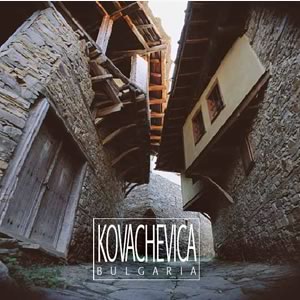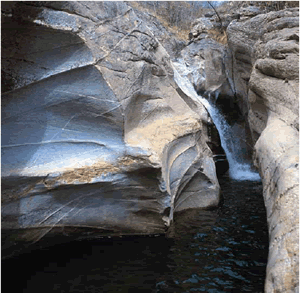
Kovachevitsa Back to History
by Mihail Enev Ph.D.
- Kovachevitsa Back to History
- A Tale of Stone and Wood
- Kovachevitsa Architecture Phenomenon
and Reserve Natural Landmarks
Click here to download the original brochure in .pdf file - 2.31 MB
 |
Kovachevitsa Back to Historyby Mihail Enev Ph.D.
Click here to download the original brochure in .pdf file - 2.31 MB |
Kovachevitsa Architecture Phenomenon
|
|
The village of Leshten is located on the slopes of the Dubvara Section of the Western Rodopi Mountain, 15 km away of the town Gotze Delchev. Its unique old houses were located at a multi-layered perspective on the steep slopes and bore all marks of the Kovachevitsa architecture style with their rich assembly solutions. The greatest landmark was the St. Parashkeva church built in 1833. It has a painted wood-carved iconostasis and antique authentic icons. The cell school was open in the same 1833, and it was transformed into a new Bulgarian school in 1891. Around the village of Leshten unique archeological sites were discovered: in the St. Atanas place – Thracian gravestones, and in the Zelenka place – remnants of an ancient town. |
 Sinia Vir
is one of the most attractive natural landmarks on the Kanina Riverside. The magnificent
natural architecture cut into the granite and gneiss rocks vast stone pots filled
with rumbling falling water. The reflections of the magnificent rocks, the woods
and the sky in the crystal clear mountain water color it in emerald blue that
named the locality the Sinia Vir (Blue Pond). Te locality is a natural alpine
phenomenon with an invaluable aesthetic and environmental worth. Alpine trout
breeds in the clear water, and in the vicinities – marjoram, tutsan, wild strawberries,
etc. Sinia Vir
is one of the most attractive natural landmarks on the Kanina Riverside. The magnificent
natural architecture cut into the granite and gneiss rocks vast stone pots filled
with rumbling falling water. The reflections of the magnificent rocks, the woods
and the sky in the crystal clear mountain water color it in emerald blue that
named the locality the Sinia Vir (Blue Pond). Te locality is a natural alpine
phenomenon with an invaluable aesthetic and environmental worth. Alpine trout
breeds in the clear water, and in the vicinities – marjoram, tutsan, wild strawberries,
etc. |
 The Kozia
Kamak landmark is a unique rock formation with an area of app. 300 m2 in the locality
of the same name in the landsite of Kovachevitsa, 14 km North of the village.
In 1976 the locality was entered in the state registers as a natural landmark
and has been under the protection of the Law on preservation. During archeological
expeditions made in 1983 the 120 holes dug during Antiquity with an identical
diameter at an identical depth in the rock formation were examined. Located on
defined geometric rows, they were similar to the ones described in the archeo-
astronomic literature holes dated 3000 B.C. in Europe, Russia, etc. The ancient
Greek philosopher and historian Herodotus pointed out exactly the Rodopi mountain
(maybe that same section of the latter) as the probable location of the famous
Dionysus’s Temple, a sanctuary of the besi Thracian tribe. It is possible that
their astronomic culture had been that elevated that it allowed for the composition
of a stellar map on the rock surface, which was done by the priests of the Dionysus
Sabasius God. Those scientific hypotheses attract numerous researchers and tourists
to the interesting locality of the Kozia Kamak, which opens an extremely beautiful
view to the famous Kalayaliiski Rocks and to the distant peaks of the Pirin mountain
to the West. The Kozia
Kamak landmark is a unique rock formation with an area of app. 300 m2 in the locality
of the same name in the landsite of Kovachevitsa, 14 km North of the village.
In 1976 the locality was entered in the state registers as a natural landmark
and has been under the protection of the Law on preservation. During archeological
expeditions made in 1983 the 120 holes dug during Antiquity with an identical
diameter at an identical depth in the rock formation were examined. Located on
defined geometric rows, they were similar to the ones described in the archeo-
astronomic literature holes dated 3000 B.C. in Europe, Russia, etc. The ancient
Greek philosopher and historian Herodotus pointed out exactly the Rodopi mountain
(maybe that same section of the latter) as the probable location of the famous
Dionysus’s Temple, a sanctuary of the besi Thracian tribe. It is possible that
their astronomic culture had been that elevated that it allowed for the composition
of a stellar map on the rock surface, which was done by the priests of the Dionysus
Sabasius God. Those scientific hypotheses attract numerous researchers and tourists
to the interesting locality of the Kozia Kamak, which opens an extremely beautiful
view to the famous Kalayaliiski Rocks and to the distant peaks of the Pirin mountain
to the West. |
 The Beslet
peak is the highest point (1938 m above the sea level) of the Beslet Hill in the
Dubrava Section of the Western Rodopi Mountain. That granite champion is surrounded
by the peaks of Malak Beslet to the Southwest, of Trite Hvoini to the Northeast,
of Cheren Kamak to the South and of Kozia Kamak to the Southeast. The peak has
a relatively smooth area with a length of 300 m and a width of 80 m. A wide vista
unveils of the latter to the Middle Rodopi Mountain as at the foreground the Skalni
Peak – Kayaliisky peak, Pogledetz, Purdikon, Drenliy, etc. are situated. The Kanina
river springs out of its Eastern slopes. Its ridge is covered by Mediterranean
low-stemmed plants, and its slopes – by alpine coniferous trees of White Pinus,
Spruce, Pine Spruce, and White Fir. The Beslet
peak is the highest point (1938 m above the sea level) of the Beslet Hill in the
Dubrava Section of the Western Rodopi Mountain. That granite champion is surrounded
by the peaks of Malak Beslet to the Southwest, of Trite Hvoini to the Northeast,
of Cheren Kamak to the South and of Kozia Kamak to the Southeast. The peak has
a relatively smooth area with a length of 300 m and a width of 80 m. A wide vista
unveils of the latter to the Middle Rodopi Mountain as at the foreground the Skalni
Peak – Kayaliisky peak, Pogledetz, Purdikon, Drenliy, etc. are situated. The Kanina
river springs out of its Eastern slopes. Its ridge is covered by Mediterranean
low-stemmed plants, and its slopes – by alpine coniferous trees of White Pinus,
Spruce, Pine Spruce, and White Fir. |
|
The village of Dolen is a typical alpine village (1020 v above the sea level), located in the Southwestern part of the Dubrava section of the Western Rodopi Mountain, 26 km away from the town of Gotze Delchev. Founded by settlers saving themselves of violent conversion to Islam during the 16th century it was noted in the Turkish Registers ever since 1671. The Renaissance architecture growth preserved to present times via the 70 houses that promulgated culture monuments rendered the latter in 1977 “Dolen Culture and Historical Reserve”. The main landmarks were the family houses among which the most famous ones were the Angelov House, the Talpa House, etc. as well as the old church built in 1834 in a complex with the cell school. Icons by Georgi Philipov, an icon-painter of the Debar region that later moved to Gabrovo were painted on the iconostasis of that church. The Kavalite, Nikolovata Chalma junctures and the bazaar alley were the most interesting typical alley assemblies. Village is a known in the past by its well-developed gold-smithy and lodgery, and at `resent timec by ctock-breeding, tobacco manufacturing and logging. The village of Ribnovo is located Northwest of the Kanina River at the foot of the Belikovitza peak. The natural surroundings of vast alpine plateaus, meadows and tobacco and potato fields set out the exclusive scenery variety and picturesqueness. |
|
On 17. 10. 2002 a Committee of permanent resident and house owners in Kovachevitsa organized an official celebration and a church service on the occasion of the 90th anniversary of the liberation of the village of the Ottoman yoke. Then an idea was conceived to establish an association that should mobilize the effort of everyone that loves and cherishes the village and also search for sources of collecting funding to preserve the cultural and historic heritage and to improve the image of Kovachevitsa as a historical and architectural reserve, and to provide means of living to the local community by creating conditions to develop rural and cultural tourism. A month later on 17. 11. 2002 the Kovachevitsa Historical and Architectural Reserve Association was established that was registered by the Blagoevgrad District Court on 21. 01. 2003 under the provisions of the Law on Non-Profit Organizations. As a first step for reach its goals the Association in collaboration with the Gurmen Municipality developed a project and applied under the PHARE Program – Cultural Tourism in Bulgaria Project. The Project was awarded and the Association signed a grant for funding by the EU under the latter program of restoration activities of the cobblestone pavement in the center of the village, reparation works of the top structure of the St. Nikola Church and full restoration of the building of the elementary school “Yordje Dimitrov” that remained unused and subject to destruction over several decades. By implementing the project a building that is an architectural monument will be preserved for generations ahead – the elementary school “Yordje Dimitrov” as well as the information and tourist bureau adapted to provide tourist services and products, a historical museum, an art and photographic gallery and a hotel. The Project includes also specific activities related to making the village popular, training local hotelkeepers, restaurant holders, alpine guides and tourist guides, preserving and making popular local authentic folklore. The members of the Association are confident that offering these new tourist products as well as executing their future activities on preserving and improving the image of the Kovachevitsa historical and architectural reserve will contribute to the advancement of rural and cultural tourism in Kovachevitsa and the nearby region and will transform them in a preferred place of relaxation and tourism. |